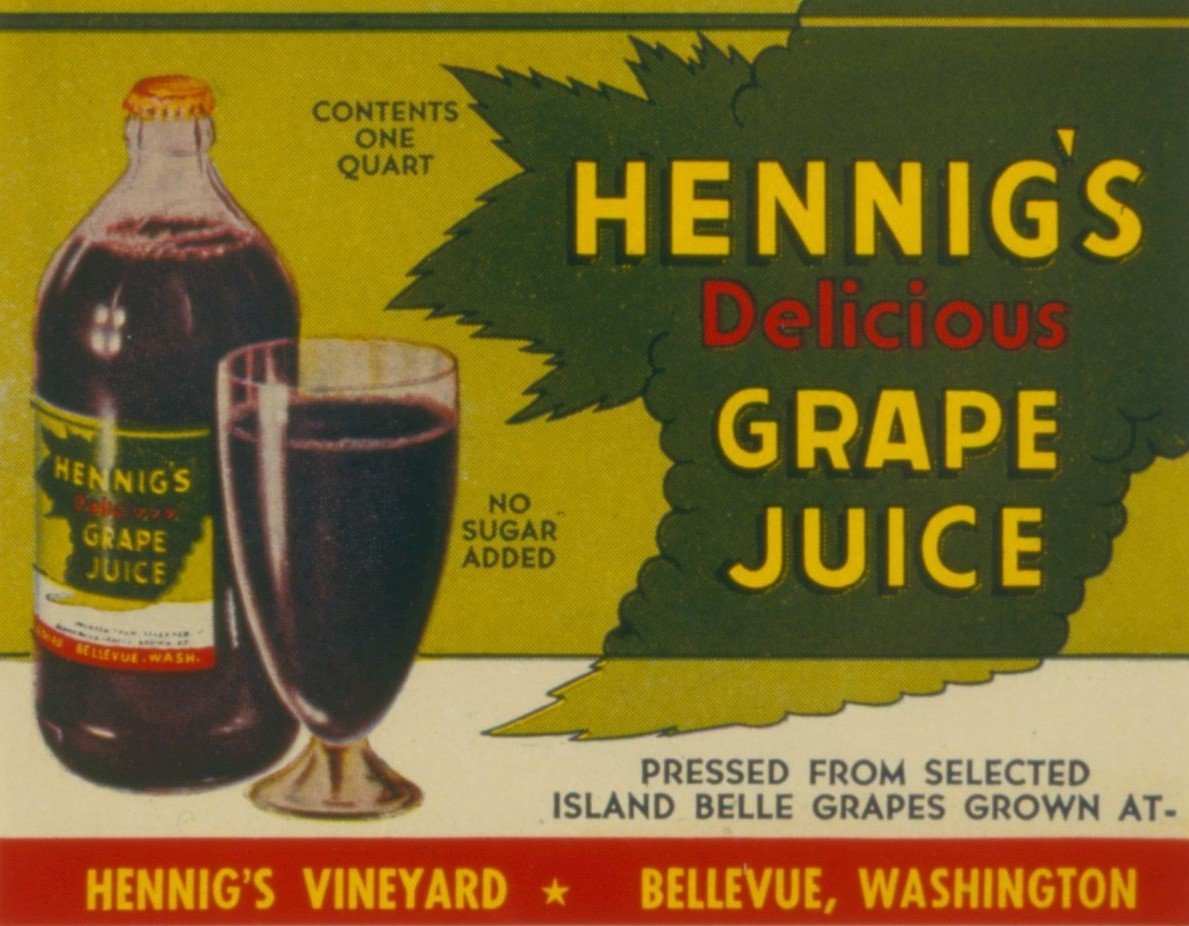BY BARB WILLIAMS, EASTSIDE HERITAGE CENTER VOLUNTEER
For thousands of years, Native Americans harvested the abundance of natural foods on the Eastside of Lake Washington. Good water, soil, and climate made Bellevue ideal for cultivated farming. Downtown was originally covered with huge, old-growth trees. Once logged, they were replaced with farmlands. Much of Bellevue’s success and growth is founded in its agricultural roots as an Eastside Cornucopia; a Horn of Plenty.
Hand drawn map of Bellevue, highlighting agricultural lands. Maker unknown, date unknown. (Reference - Vertical Files)
Early European settlers farmed to support their daily needs followed by cash crop farming for markets. A multitude of successful animal, fruit and vegetable farms sprang up and reached their peak between 1920 and 1942. The distribution of vegetables, fruits, bulb, and ornamental plants to local, national, and international markets was expanded after 1904 when the Northern Pacific Railroad connected Eastside produce to Seattle and beyond. Construction and operation of the Bellevue Growers Association Packing Shed (c. 1933) alongside the NPR railroad tracks at Midlakes significantly enhanced the transportation of the agricultural abundance of Bellevue farms.
In 1889, Ove and Mary Larsen gained title to 160 acres of land at Larsen Lake; a favorite gathering place for Native Americans who had harvested wild cranberries and blue huckleberries there. Ove did the same selling the berries for 50 cents a gallon. He worked at the Newcastle coal mines and farmed on weekends. In 1913, he sold half the property to the Aries brothers; Louis, Tony, and Albert from South Park, Seattle. Their property stretched from Larsen Lake to NE 8th. They grew cabbage, corn, squash, peas, wax beans, cauliflower, carrots, potatoes, celery, and iceberg lettuce; the latter for which they became famous. It was distributed to local, Philippine Islands, Alaska, and Yukon Territory markets. At peak production, they shipped seven railroad carloads of iceberg lettuce and 4,000 sacks of potatoes.
Aries family harvesting lettuce, 1918. (OR/L 79.79.232)
In 1912, J. Kelfner sold Island Belle grapes grown on his farm at 108th Avenue and SE 8th Street. In the 1930s, he sold nine tons of grapes to one buyer. Adolph Hennig also grew Island Belle grapes at his vineyard on Clyde Hill. He designed and built equipment for pasteurizing and extracting juice. This proved beneficial in 1929 when fresh grapes were selling for only 1 cent per pound, but juice could be stored and sold year-round.
Mary Cruse and Grace Hill in Baker House daffodil garden, 1912. (2001.114.001)
Apples, cherries, pears, and strawberries were profitable cash crops. With the help of Japanese farmers between the 1920s to 1940s, the abundance of strawberries became a profitable and popular crop for Bellevue. Fields of strawberries stretched over the hills providing an incentive for the Strawberry Festival which began in 1925. After WWII, blueberries replaced strawberries as the popular fruit. In preserving this heritage, the City of Bellevue presently owns and operates U-Pick blueberry fields at Larsen Lake and Overlake blueberry farms.
Delkin Bulb Farms, c.1990s (2016.010.004)
Following the example of successful bulb farms in Bellingham, bulb farming was begun in Bellevue in the 1920s. The Boddy family cultivated vegetables and bulb plants growing cucumbers and Easter Lilies in their greenhouses on Hunt’s Point. William Cruse grew fruits and daffodils. His home, the Baker house, and gardens were located where the QFC now stands. Frederick J. Delkin, the owner and operator of Delkin Farms wholesale nursery business, established a warehouse accessible to the railroad tracks at Midlakes in 1926. At one time, he shipped an entire railroad carload of iris and narcissus bulbs to New York.
Perhaps this shipment included bulbs from Cecelia and Frederick Winters bulb farm at the Mercer Slough. Originally they grew vegetables, the abundance of which they sold to summer people at Beaux Arts. In 1924, they switched to iris and daffodil bulbs grown in greenhouses. Andre Ostbo bought several acres of their land in the 1930s and started a successful rhododendron business called “The King of Shrubs” for which he became famous. The Winters’ Spanish-eclectic style house, built in the late 1920s, is presently owned by the City of Bellevue and located on Bellevue Way. Remnants of the many greenhouses and escaped rhododendrons can be seen along the Ostbo Loop trail as can the sinking boiler house used to send steam through pipes to the greenhouses.
It is possible that Andre knew Cal and Harriet Shorts who bought a farm on Main Street in 1946. Their specialty was rhododendrons. In 1984, the Shorts donated their 7.5 acres and home to the City of Bellevue for a park and botanical garden. Today, the Bellevue Botanical Garden is open to the public year-round with the Shorts house at its center. Thanks to the generosity of the Shorts, and visionaries like Iris and Bob Jewett, the Garden is a treasure that reflects the bountiful agricultural possibilities and heritage of Bellevue: an Eastside Cornucopia.
Resources:
Eastside Heritage Center archives
Lake Washington the Eastside. by Eastside Heritage Center, Arcadia Publishing, 2006
Bellevue, Its First 100 Years. by Lucile McDonald, Bellevue Historical Society, 2000
The Bellevue Botanical Garden: celebrating the first 15 years. by Marty Wingate, The Bellevue Botanical Garden Society, 2007








